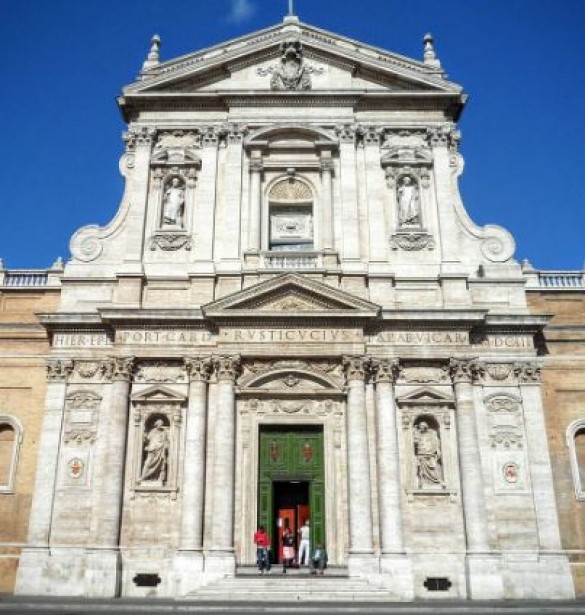
The church of Saint Susanna at the Baths of Diocletian is a Roman Catholic parish church situated in Quirinal Hills, Rome, Italy. There has been tirtular churches associated to its sites as far as back AD280. The church is served as the national parish for resident of Rome.
Santa Susanna, also known as the Church of Saint Susanna at the Baths of Diocletian, holds a long and fascinating history that dates back to ancient times. The church stands on the site of the ancient Baths of Diocletian, the largest public baths in ancient Rome, built by Emperor Diocletian in the 3rd century AD.
During the early Christian period, the baths were transformed into a place of worship. The original church dedicated to Saint Susanna, a Roman martyr, was built around the 4th century. However, over the centuries, the church underwent numerous restorations and renovations.
Also read: Vardzia Cave City: A Marvel of Ancient Georgia
The architecture of Santa Susanna is a blend of various styles that reflects the transformations it has gone through over the centuries. The exterior facade showcases a beautiful combination of Renaissance, Baroque, and Neoclassical elements.
The church's main entrance features a striking portico with Corinthian columns, typical of Roman Neoclassical architecture. Above the entrance, an elegant triangular pediment stands, adorned with intricate sculptures and reliefs. The facade is embellished with statues of various saints, adding to its grandeur.
The interior of Santa Susanna is equally impressive. The high altar is an exquisite work of art, created by Carlo Maderno, a prominent architect of the Baroque period. The main altar's centerpiece is a beautiful painting representing the martyrdom of Saint Susanna, attributed to the renowned artist Giovanni Battista Crescenzi.
Also read: The Serenity of Seychelles: Secluded Beaches and Island Adventures
Other notable elements of the interior include stunning frescoes, intricate stuccoworks, and elegant marble statues that represent the artistic prowess of different periods throughout history.
Santa Susanna has always held immense spiritual significance for the Christian community in Rome. Dedicated to Saint Susanna, a Roman martyr, the church is a place of reverence and pilgrimage for many believers. Saint Susanna was executed during the Diocletianic Persecution, a time when Christians faced severe persecution in the Roman Empire.
The church has been associated with the Discalced Carmelite Order since the 16th century. It has served as the National Parish for American Catholics in Rome since 1921, making it a significant spiritual center for the American community living in the city.
Also read: Exploring the Croatian Coastline: Sailing the Adriatic and Visiting Dubrovnik
In addition to its regular worship services, Santa Susanna plays a vital role in the spiritual life of pilgrims visiting Rome. Many visitors come to the church seeking moments of solace and reflection, connecting with its historical roots and religious heritage.
Santa Susanna has become a vibrant community that welcomes people from diverse backgrounds and cultures. The church's mission is not only to cater to the spiritual needs of its congregation but also to extend a helping hand to those in need.
The church regularly hosts various cultural events, concerts, and art exhibitions, fostering a sense of inclusivity and camaraderie among its members and visitors. Additionally, it actively engages in outreach programs, assisting the less fortunate through charitable initiatives and social services.
Also read: Brandenburg: A Historical and Cultural Gem in Germany
Due to its historical significance, captivating architecture, and spiritual aura, Santa Susanna attracts a considerable number of tourists and visitors from around the world. Many tourists are drawn not only to the church's beauty but also to its connection to ancient Roman history and early Christian heritage.
The church offers guided tours, providing insights into its historical and artistic treasures. Visitors can explore the breathtaking interiors, learn about the various restorations, and understand the church's place in Roman and Christian history.
Also read: Adventure in New Zealand's South Island: Queenstown, Milford Sound, and Glacier Country
Santa Susanna is a remarkable testament to the intertwined history of ancient Rome and early Christianity. Its magnificent architecture, rich history, and spiritual significance make it a must-visit destination for tourists and a place of solace and devotion for believers. Whether one is interested in art, history, or spirituality, Santa Susanna offers a captivating experience that leaves a lasting impression on all who visit this extraordinary church in the heart of Rome.
Also read: Palma de Mallorca: The Enchanting Capital of Spain's Balearic Islands
Island Hopping in the Azores, Portugal: Unveiling the Enchanting Treasures of the Atlantic